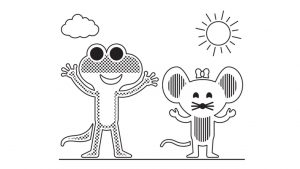Using Their Fingers, Blind Children Learn Music and Languages with Lux+Louise
Building on her son’s love of music, singing, moving, and reading, Laura Steinbusch created a multilingual children’s songbook called Lux+Louise to help youngsters learn music by braille.
 With songs in Dutch, English, French and German, the songbook’s characters, Lux the lizard and Louise the mouse, help expose children with blindness or visual impairment to learning other languages from an early age and allow them to independently explore the world.
With songs in Dutch, English, French and German, the songbook’s characters, Lux the lizard and Louise the mouse, help expose children with blindness or visual impairment to learning other languages from an early age and allow them to independently explore the world.
Laura came up with the idea because her son, Enzo, now 6, easily learned new words early on through songs in French or English, especially when he already knew them in Dutch.
Enzo was born in 2014 in Lausanne, Switzerland, and genetically diagnosed at 18 months with LCA10-CEP290, a form of Leber congenital amaurosis causing severe retinal dystrophy because of mutations in the CEP290 gene. Enzo lives in The Netherlands with his mom and his dad, Merlijn, and his new little sister, Maud.
He started to learn braille when he was 5 and he enjoys it a lot, his mom said.
“His favorite story is ‘the story of the little mole who knew it was none of his business,’ which we had to buy in the four
languages of my songbook because he wants to know the whole story in those four languages.”
Lux+Louise contains five popular children’s songs with printing in black and in braille and six visual and tactile illustrations with explanations and questions. Along with singing about a bus and a spider, the book helps with learning body parts and movement.
“This makes it easier for blind children to connect the song texts to the tactile illustrations and the real world,” Laura said. The songs can also be played on the piano or flute.
“Most children adore singing; some children even sing before they speak,” she said. “Blind or visually impaired children use their hearing all the time and mostly enjoy music and making noise … Independence is also important for learning music. It would be best if blind children could learn reading braille music as soon as they have learned to read braille text.”
The songs are: “A Ram Sam Sam,” “Head Shoulders Knees and Toes,” “Are You Sleeping (Brother John)?” “The Wheels on the Bus,” and “Itsy Bitsy Spider.”
“I hope people enjoy learning another language through music and learn to read music braille,” Laura said. “In the end, I hope it helps blind kids explore the technical world on their own.”
Listen for yourself via YouTube or Spotify.
You can order the book on the Lux+Louise website.

